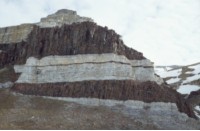The geology of Svalbard
 The photograph shows a mountain built of limestone (white) and dolerite (dark). The dark stripes are dolerite sills, which have intruded the horizontal limestone strata. The limestone is Carboniferous in age whereas the dolerite is Mesozoic.
Illustration: Dierk Blomeier, NPI
Arctic Ltd stands on a firm basis. Nowhere else in northern Europe are so many geological periods preserved in the bedrock. As there is little or no vegetation here, the bedrock is exposed over large areas. The geological succession in Svalbard can be broadly divided into three divisions, the ancient basement (Precambrian and Early Palaeozoic), non-metamorphosed sedimentary rocks (Late Palaeozoic to Tertiary), and young, unconsolidated sediments (Quaternary).
The photograph shows a mountain built of limestone (white) and dolerite (dark). The dark stripes are dolerite sills, which have intruded the horizontal limestone strata. The limestone is Carboniferous in age whereas the dolerite is Mesozoic.
Illustration: Dierk Blomeier, NPI
Arctic Ltd stands on a firm basis. Nowhere else in northern Europe are so many geological periods preserved in the bedrock. As there is little or no vegetation here, the bedrock is exposed over large areas. The geological succession in Svalbard can be broadly divided into three divisions, the ancient basement (Precambrian and Early Palaeozoic), non-metamorphosed sedimentary rocks (Late Palaeozoic to Tertiary), and young, unconsolidated sediments (Quaternary).
The basement is the oldest bedrock. In Svalbard, these rocks have undergone the Caledonian Orogeny and are older than 410 million years. They have suffered strong movements and alteration, and were folded, thrust and chemically transformed under high pressure and temperature at a great depth. Those which are now at the surface were formed up to 80 km beneath the surface.
The basement bedrock was eroded during the Devonian Period and vast quantities of sand, gravel and mud formed which were deposited on river plains and in the sea. In the succeeding geological periods, the area mostly lay beneath the sea and marine sedimentary rocks formed, but there were short intervals when land areas rose out of the sea. The Svalbard area was often a shallow sea and islands periodically appeared which were inhabited by such creatures as plesiosaurs and iguanodons. Icthyosaurs lived in the sea.
The earth's crust fractured during the Cretaceous Period and a rift system formed which would subsequently develop into the Atlantic Ocean. The whole of the Svalbard region became a land area in the Late Cretaceous. The sea-floor spreading began in earnest in the Early Tertiary. The north-western corner of Europe was torn from Greenland along an enormous fault, and during this process western Spitsbergen was folded up to form a new mountain chain.
The present geological era is called the Quaternary and this is the first period since the Permian, 245 million years ago, when there have been real ice ages. The heavy masses of ice on land depressed the Earth's crust and the sea partly invaded the land. After most of the ice melted, the land has risen again.
Present-day geological processes in Svalbard are strongly marked by permafrost and glaciers. A typical feature of the Arctic is the permafrost which forms arctic landforms like rock glaciers, patterned ground and pingos, and much of the sedimentation that occurs today is linked with the transport of eroded material from glaciers and glacial rivers.
Did you know...
 Jotunkjeldene and Trollkjeldene are two hot springs in Svalbard. They are fed by groundwater which is heated so that the temperature at the surface is 20 °C or warmer the whole year round. This spring water contains dissolved minerals from the bedrock and these crystallise when the water reaches the surface. Terraces, mainly composed of carbonate deposits, have therefore built up around the springs. Mosses and algae that do not otherwise occur in Svalbard grow at these springs.
Jotunkjeldene and Trollkjeldene are two hot springs in Svalbard. They are fed by groundwater which is heated so that the temperature at the surface is 20 °C or warmer the whole year round. This spring water contains dissolved minerals from the bedrock and these crystallise when the water reaches the surface. Terraces, mainly composed of carbonate deposits, have therefore built up around the springs. Mosses and algae that do not otherwise occur in Svalbard grow at these springs.
 Geological time scale. The formation of what is now Svalbard began in the Precambrian and the Lower Palaeozoic, more than 410 million years ago. We are now in the Quaternary Era, which has lasted for the past 2 million years. Man, or Homo sapiens, evolved more than 200 000 years ago. The Age of Man is therefore right at the very top of the time scale, just brushing the hair on the mammoth's head.
Geological time scale. The formation of what is now Svalbard began in the Precambrian and the Lower Palaeozoic, more than 410 million years ago. We are now in the Quaternary Era, which has lasted for the past 2 million years. Man, or Homo sapiens, evolved more than 200 000 years ago. The Age of Man is therefore right at the very top of the time scale, just brushing the hair on the mammoth's head.
Illustration: NPI